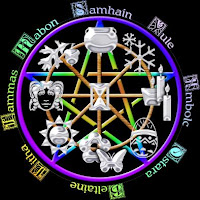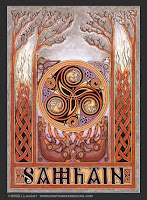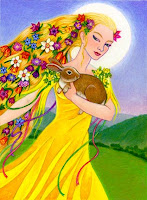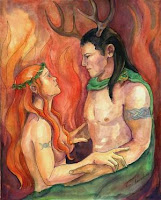>
Right now we are in the season of Imbolc, which is a sabbat usually celebrated in the first few days of February, along with my birthday. This is my season. I don’t think it’s a coincidence that I have begun studying the Old Religion in the season of my birth. I also find that I identify with the goddess in which this season honors. Her name is Brigid (with varying spellings over the years in different cultures). When I was studying the different sabbats and the Wiccan calendar in this blog, I briefly touched on Brigid’s role in Imbolc and I immediately felt the pull to study her further.
I think Brigid is very revered and honored today because she has several faces (quite literally) and manages carrying herself in a masculine world, much like women in this modern age. She is so revered that she was a pagan goddess that became a Catholic saint. St. Brigid’s Day is February 1, which was typically the festival of Imbolc. Brigid originates in Irish mythology. Her name means “the exalted one” and she was the daughter of the Dagda, who was a very important god of Irish mythology as well, being known as “all-father” and the protector of the tribe. She had two sisters, also named Brigid, and therefore, this makes her known as the triple goddess, often depicted with three faces. She has two oxen, Fe and Men, a boar known as the king of boars present in Arthurian legend, and the king of sheep too. For this reason, she is associated with sheep and other animals that begin the rebirth season during Imbolc. The word Imbolc comes from the lactation of the ewes, the flow of milk that heralds the return of the life-giving forces of spring. Later, the Catholic Church replaced this festival with Candlemas Day on February 2, which is dedicated to the Virgin Mary and features candlelight processions. The powerful figure of Brigid the Light-Bringer overlights both pagan and Christian celebrations.
Brigid’s divine responsibilities are many and varied. She is considered a mother goddess and goes back as far as the word brihati in Vedic Sanskrit, which is an epithet of the divine. Her wisdom is vast, being the one to inspire and protect poets. In her time, poetry was associated with seers and that made her seen as the great inspiration behind divination and prophecy, the source of oracles. Given my profession, I found that rather interesting.
Her two sisters are Brigid the Physician and Brigid the Smith but it seems to me that the three sisters are basically just three facets to the same triple goddess. She is a healer and a master of the flame in these other two faces of her existence. When Christianity came to Ireland, this goddess was transformed into a saint who was able to miraculously increase the milk and butter production from cattle in Kildare. Interestingly enough, my ancient Irish ancestry came from Kildare! Brigid is my lady! There are lengthy legends and tales about Brigid being the keeper of the flame and it extended fully into her incarnation of Saint Brigid as well. The fire, the light in association with the festival of Imbolc involves giving hope that the death of winter will soon be over and the rebirth of spring will soon come. Candlemas was celebrated in Christianity all the way up until the Reformation. Again we see symbols of light chasing away the darkness for humanity. The third side to Brigid is her ability to heal and many healing wells and springs are named after her in Ireland.
In the celebration of Imbolc, it’s time to clean your home and remove everything associated with Yule, the season prior to Imbolc. Beginning on February 1, it is appropriate to make Brigid’s crosses out of rushes or straw and hang them mainly in the kitchen where your food will be blessed. The crosses can also protect your home from fire and evil, should Brigid choose to bless you. Also on February 1, it is appropriate to put offerings of milk, bread, butter and cake outside of your door for Brigid and her cow as they walk through your neighborhood that night. Also leave a silk ribbon on your doorstep for Brigid to bless that night and you will be able to use it later for healing purposes. Meditation upon the issues of growth in health and strength in the coming year for yourself, your family, your community, the planet, the universe, etc., and asking Brigid for her blessing in those endeavors is also necessary during the Imbolc season. Put candles in your windows as symbols of the rebirth of the sun. Honor the Maiden as she prepares to be a bride by decorating your home with white flowers and offering them to her.
Read More
























